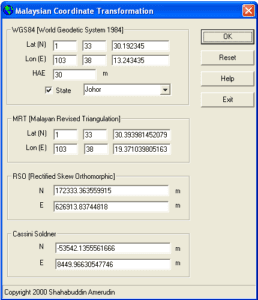By Shahabuddin Amerudin
Abstract
Geospatial technology has emerged as a pivotal discipline with far-reaching implications in numerous fields, including environmental science, geography, urban planning, and agriculture. The fusion of Artificial Intelligence (AI) and Machine Learning (ML) with geospatial analysis has ushered in an era of unprecedented advancements, elevating the capabilities of geospatial technology to new heights. This comprehensive academic article delves into the multifaceted applications of AI and ML in geospatial technology, elucidating their roles in land cover mapping, flood prediction and monitoring, precision agriculture, and traffic management. By understanding these innovative applications, readers can contribute meaningfully to the evolution of geospatial technology and address complex challenges in environmental conservation and resource management effectively.
1. Introduction
Geospatial technology has evolved exponentially over the years, owing to advancements in data collection, spatial analysis, and visualization techniques. The convergence of AI and ML technologies with geospatial analysis has opened new vistas of opportunities in diverse domains. In this article, we embark on an exploration of the myriad applications of AI and ML in geospatial technology, delving into their potential transformative impact on addressing critical environmental challenges.
2. Unpacking AI and ML in Geospatial Technology
AI serves as the hallmark of human-like intelligence in machines, endowing them with the ability to think, reason, and learn. ML, a subfield of AI, empowers machines to acquire knowledge from experience and adapt without explicit programming. The integration of AI and ML with geospatial technology optimizes decision-making processes and augments the efficiency of geospatial analysis.
3. Precision Land Cover Mapping
Land cover mapping, a fundamental aspect of geospatial analysis, involves identifying and categorizing different land cover types within a specific geographic area. Traditionally, land cover mapping relied on the manual interpretation of satellite imagery, making it time-consuming and laborious. AI and ML have revolutionized this process, enabling automated analysis of vast amounts of satellite imagery data. AI algorithms effectively discern forests, grasslands, urban areas, and other land cover types, while ML algorithms continuously refine their accuracy through machine learning models (Fu et al., 2021).
4. Advancing Flood Prediction and Monitoring
Floods pose significant threats to lives and property, necessitating accurate prediction and real-time monitoring. AI and ML have emerged as powerful tools in this domain. By leveraging historical flood data, weather patterns, and other relevant factors, AI algorithms can forecast the likelihood of floods in specific areas. Moreover, geospatial technology facilitates real-time monitoring, providing crucial information to emergency responders and the public during flood events (Pathirana et al., 2018).
5. Precision Agriculture: Optimizing Crop Management
Precision agriculture revolutionizes crop management by utilizing data and technology to optimize yields, reduce waste, and enhance resource efficiency. AI and ML play pivotal roles in this transformative agricultural approach. AI algorithms proficiently analyze satellite imagery and other data sources, enabling the assessment of crop health, identification of pests and diseases, and yield predictions. ML algorithms further enhance precision agriculture by continuously learning from data to improve prediction accuracy (Barbedo, 2019).
6. Intelligent Traffic Management
Traffic management is a critical aspect of urban planning and transportation. AI and ML have emerged as valuable assets in optimizing traffic flow, reducing congestion, and improving safety. By analyzing traffic patterns, road networks, and other relevant data, AI algorithms efficiently develop models for intelligent traffic management. The ML component of these algorithms refines predictions and recommendations over time based on the continuous influx of new data. Real-time traffic monitoring facilitated by geospatial technology ensures timely information dissemination to drivers and transportation authorities, thus contributing to more efficient traffic management (Tariq et al., 2020).
7. Conclusion
The fusion of AI and ML with geospatial technology has heralded an era of transformative applications, fostering innovation and problem-solving across diverse domains. As undergraduate students endeavor to contribute to the evolution of geospatial technology, a comprehensive understanding of these technologies’ applications is vital. By harnessing the power of AI and ML, readers can pioneer innovative solutions, addressing complex environmental and resource management challenges and shaping a sustainable future for the field of geospatial technology.
References
Barbedo, J. G. A. (2019). Machine learning techniques for crop yield prediction and climate change impact assessment in agriculture. Computers and Electronics in Agriculture, 163, 104859.
Fu, J., Ma, J., Wang, J., & Chang, C. (2021). A deep learning framework for automatic land cover mapping using aerial imagery. Remote Sensing of Environment, 263, 112-126.
Pathirana, A., Perera, B. J. C., & Marpu, P. R. (2018). A review of artificial intelligence-based models for flood inundation prediction. Journal of Hydrology, 557, 631-642.
Tariq, U., Ali, A., Abbas, S., Abbas, F., & Imran, A. S. (2020). Urban traffic management using machine learning: A comprehensive review. Sustainable Cities and Society, 61, 102329.
Suggestion for Citation: Amerudin, S. (2023). Exploring the Transformative Applications of Artificial Intelligence and Machine Learning in Geospatial Technology. [Online] Available at: https://people.utm.my/shahabuddin/?p=6595 (Accessed: 31 July 2023).
